Top 10 Health Sciences Connect stories of 2024
The immense potential of integrating AI into health sciences research, five faculty profiles and two leadership Q&As were among your favorite stories.
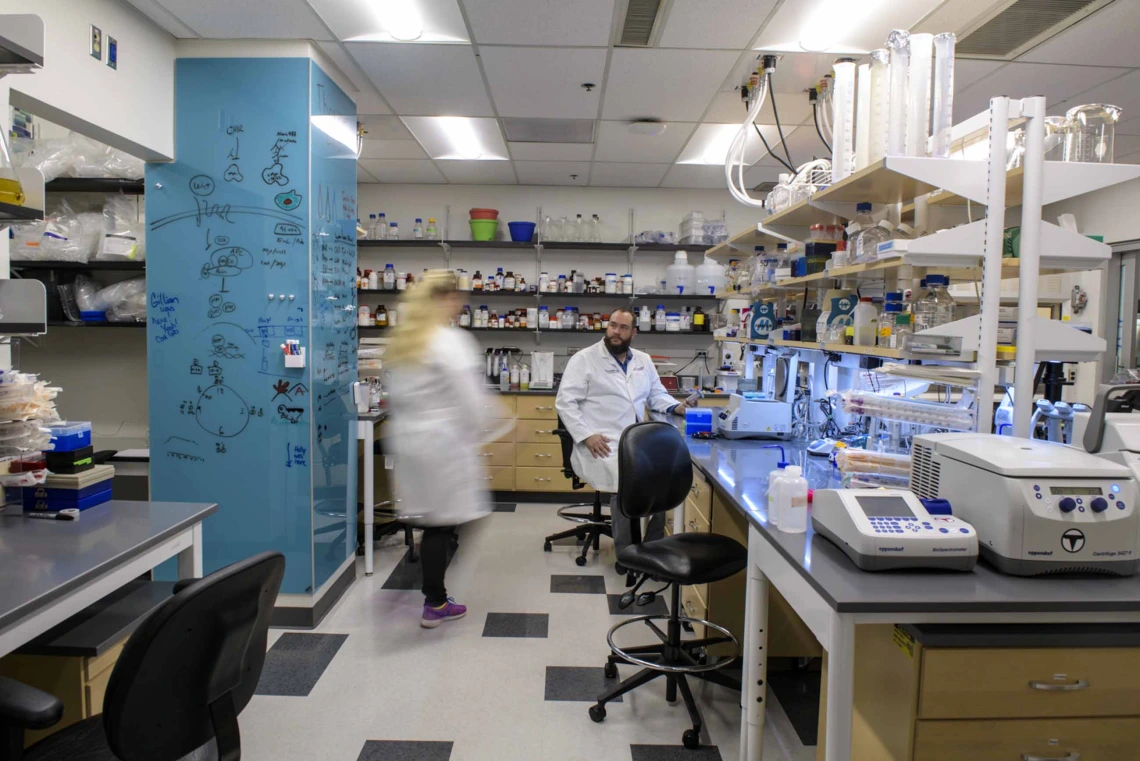
Though he spends his days in a sterile lab, Curtis Thorne loves gardening and originally planned to study botany in college.
Photo by Kris Hanning, U of A Health Sciences Office of Communications
With the promise of 2025 ahead of us, let’s look at the top 10 Health Sciences Connect stories of 2024 before we move too far into the new year. Last year’s most-viewed stories covered how the 1944 GI Bill helped launch the University of Arizona Health Sciences’ oldest college, how the Gilbert Simulation Center prepares future nurses, five faculty profiles and two Q&As with Health Sciences leaders.

Nicola Baker, MD, a clinical assistant professor at the University of Arizona College of Medicine – Tucson, was part of a team of health care professionals who climbed Aconcagua, the tallest mountain in the Americas, in January.
Photo courtesy of Myung Bae
Emergency medicine professor reaches new heights in wilderness medicine
March 18, 2024
Nicola Baker, MD, is a clinical assistant professor and emergency medicine physician at the University of Arizona College of Medicine – Tucson and is fellowship-trained in emergency ultrasound. Baker’s affinity for mountain climbing pairs well with her passion for wilderness medicine. On a recent summit of Aconcagua — the tallest mountain in the Americas — Baker and her climbing team of health care professionals were learning how to prevent and treat emergencies at altitude. She also taught a session at the base camp medical tent to physicians from Extreme Medicine, the elite Argentinean team that provides medical care and rescue services on Aconcagua, focusing on the use of portable ultrasound in expedition medicine and at extreme altitudes.
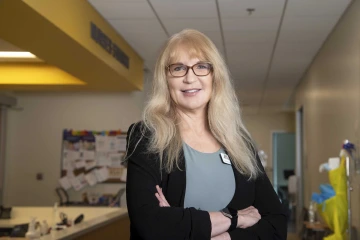
Janine Hinton, PhD, an associate clinical professor and director of the Steele Innovative Learning Center with the UArizona College of Nursing.
Photo by Noelle Haro-Gomez, U of A Health Sciences Office of Communications
Gilbert simulation center gets student nurses ready for real world
May 6, 2024
Janine Hinton, PhD, an associate clinical professor and director of the Steele Innovative Learning Center at the U of A College of Nursing, is in charge of simulation-based education for the college in both Gilbert and Tucson. Virtual, augmented and extended reality are part of the simulation experience at the Gilbert Simulation Center, which has one goal: make nurses better. Simulations at the center cover diverse challenges, such as obstetrical emergencies, patient resistance and high-pressure environments. Students practice repeatedly, developing muscle memory for critical tasks. By offering a safe, controlled environment for skill-building, the program ensures that nursing graduates are better equipped to handle the demands of real-world health care, ultimately improving patient outcomes.
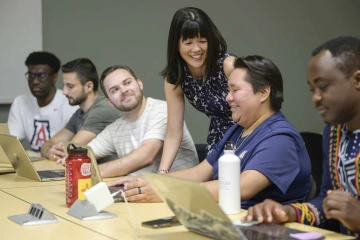
Mel and Enid Zuckerman College of Public Health associate professor Nicole Yuan, PhD, MPH, enjoys teaching and mentoring the next generation of public health professionals.
Photo by Kris Hanning, U of A Health Sciences Office of Communications
Professor makes mental health, resiliency a priority for students, herself
May 20, 2024
Nicole Yuan, PhD, MPH, an associate professor and program director of Health Behavior and Health Promotion in the Department of Health Promotion Sciences at the U of A Mel and Enid Zuckerman College of Public Health, takes a holistic approach to teaching, with the goal of promoting students’ academic success, health and well-being. Originally trained as a clinical psychologist, Yuan transitioned to public health due to her attraction to prevention-focused strategies that tackle mental health and health disparities. Her work spans research on Indigenous communities, resiliency, women’s health and positive childhood experiences, emphasizing strengths-based frameworks to empower individuals and reduce stigma. Yuan also co-chairs ResilienceCon, a multidisciplinary conference fostering interactive discussions on resilience and adversity.

American troops wade ashore on Omaha Beach during the D-Day invasion on June 6, 1944. D-Day, one of history’s toughest, most important battles, marked the turning point of World War II.
Photo courtesy Vernon Lewis Gallery/Stocktrek Images via Getty Images
WWII soldiers liberated Europe, then helped build Pharmacy
June 6, 2024
Chuck Gin and Albert Picchioni, PhD, exemplify the resilience and commitment of WWII veterans who leveraged the GI Bill for new beginnings following the war. Gin, balancing studies at the newly founded U of A College of Pharmacy (now the R. Ken Coit College of Pharmacy) with work and family obligations, became a respected pharmacist in Tucson. His dedication to service extended beyond the war, as he worked long hours at his drugstore to support his community. Similarly, Picchioni, a former combat medic, used the GI Bill to pursue advanced pharmacology studies, eventually becoming the university’s first full-time pharmacology professor. Over a 35-year career, he was instrumental in pioneering the Arizona Poison and Drug Information Center.
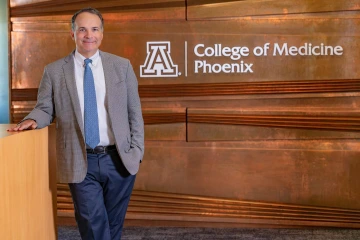
University of Arizona College of Medicine – Phoenix Dean Fred Wondisford, MD.
Photo by Shaun Mockoski, U of A College of Medicine – Phoenix
Connecting with Dean Fred Wondisford
July 1, 2024
Fred Wondisford, MD, MS, MBA, took over as dean of the U of A College of Medicine – Phoenix in October 2023. He said his plan for the future is to transition the college to a more research-oriented focus. Wondisford envisions collaboration with Arizona State University’s future medical school, emphasizing the state’s need for more physicians and innovative partnerships. He also highlights the role of the Center for Advanced Molecular and Immunological Therapies, or CAMI, in strengthening research in autoimmunity, infectious diseases and cancer. Wondisford wants the College of Medicine – Phoenix to be known for its innovation and for expanding health care training to underserved communities across the state.
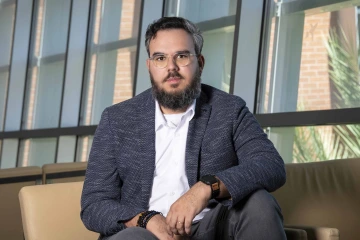
As a startup founder and public health researcher, Onicio Leal Neto, PhD, MPH, has been at the forefront of mixing technology with disease detection.
Photo by Noelle Haro-Gomez, U of A Health Sciences Office of Communications
Public Health scientist leverages evolving technology to track diseases
July 29, 2024
Onicio Leal, PhD, MPH, an assistant research professor of digital epidemiology at the Zuckerman College of Public Health, will oversee the digital disease surveillance platform Global Flu View, a program he helped create as part of the nonprofit Ending Pandemics. Ending Pandemics gave Global Flu View as a gift, along with some funding, to the college’s Global Health Institute in June 2023. Born in Brazil, Leal co-founded Epitrack, a digital epidemiology startup that was used by the Brazilian Ministry of Health when Brazil hosted the 2014 FIFA World Cup and the 2016 Summer Olympics and during the COVID-19 pandemic. The platform was the world’s first application of participatory surveillance in mass gatherings and garnered significant media attention globally.
“People are becoming aware of the potential of digital epidemiology and how they and our college can play an important role in this field,” Leal said. “I am really committed to seeing change and to teaching public health students how to use technology to understand and solve the new problems emerging in our world.”
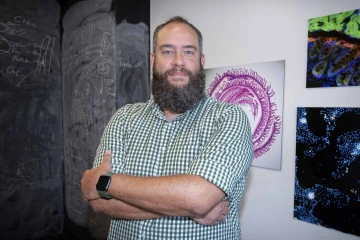
Though cancer has had a profound and prominent role in his life, Curtis Thorne, PhD, an associate professor in the University of Arizona College of Medicine – Tucson’s Department of Cellular and Molecular Medicine and a member of the U of A Cancer Center, initially resisted being a cancer researcher.
Photo by Noelle Haro-Gomez, U of A Health Sciences Office of Communications
For researcher, fight against cancer is personal
Aug. 12, 2024
Curtis Thorne, PhD, an associate professor in the College of Medicine – Tucson’s Department of Cellular and Molecular Medicine and a member of the Cancer Center, is both a cancer survivor and a cancer researcher. Thorne lost two of his older brothers to cancer. After he was diagnosed with cancer, he underwent successful chemotherapy treatment. Now he searches for a cure. The Thorne Lab studies the basic biology of tissue renewal in the gastrointestinal tract and how it can morph into cancer. In spite of the tremendous challenge, Thorne remains an optimist. “My perspective is, what a joy it is to be doing what we do,” he said. “We get paid to show up to a room and ask a tough question about a disease and try to solve it, with the long-term goal of easing the pain and suffering others feel. That’s just a joy to do. That’s worth your time.”
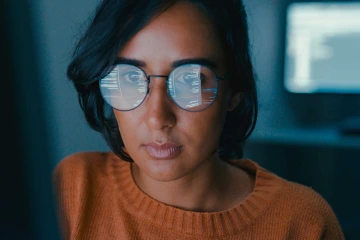
Using artificial intelligence in research can help make some tedious tasks easier but ensuring the data is free of biases and misinformation can aid in accuracy.
Photo by Getty Images
Integrating AI into research may revolutionize outcomes
Aug. 26, 2024
Colleges and researchers across the University of Arizona Health Sciences are increasingly using artificial intelligence in research, teaching and patient care. AI algorithms can quickly analyze massive datasets, predict patient outcomes and help instructors write learning objectives, create test questions and edit work. This technology has immense potential, but it also raises ethical concerns about how AI should be integrated into health care.
As researchers pointed out, ensuring that data is free of bias and researchers interpret the findings rather than relying solely on the output of an AI application can ensure a successful outcome.

Stephen Dahmer, MD, the director of the Andrew Weil Center for Integrative Medicine, says the center can be a leader in transforming health care in the 21st century.
Photo by Noelle Haro-Gomez, U of A Health Sciences Office of Communications
Connecting with Stephen Dahmer, MD
Sept. 9, 2024
Stephen Dahmer, MD, director of the Andrew Weil Center for Integrative Medicine, talked about what brought him to the center from the Icahn School of Medicine at Mount Sinai in New York City and his newfound interest in Arizona’s weather. He views integrative medicine as the most promising means to realistically achieve the “quintuple aim” in health care. “The quintuple aim expands health care goals to improve population health, enhance the patient experience, reduce costs, support health care worker well-being and advance health equity,” he said. Dahmer sees collaboration as an essential element of integrative medicine and noted the rich history of working together across the U of A Health Sciences. His plan as director is to build on that foundation and those connections to explore new opportunities.
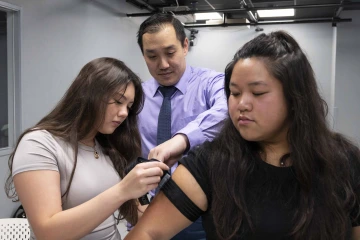
In the U of A Health Sciences SensorLab, Jonathan Lee-Confer, PhD, helps a student fit an arm sensor on a test subject before gathering data from simulated falls.
Photo by Noelle Haro-Gomez, U of A Health Sciences Office of Communications
Preventing falls a deeply personal mission for researcher
Sept. 23, 2024
Jonathan Lee-Confer, PhD, an assistant professor in the developing Doctor of Physical Therapy program at the U of A College of Health Sciences,is on a mission to prevent falls in older adults. The conventional physical therapy approach to improve balance is to strengthen the legs, but Lee-Confer suggests that arm movements also help maintain balance during slips and falls. Getting a better understanding of how arm movements improve balance may help clinicians develop more thorough fall-prevention strategies in this population. Lee-Confer also draws on his experience receiving physical therapy after several tennis injuries to inform the way he hopes to develop the new program.

